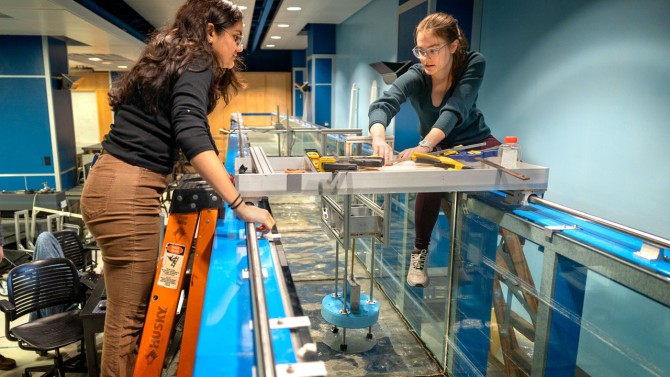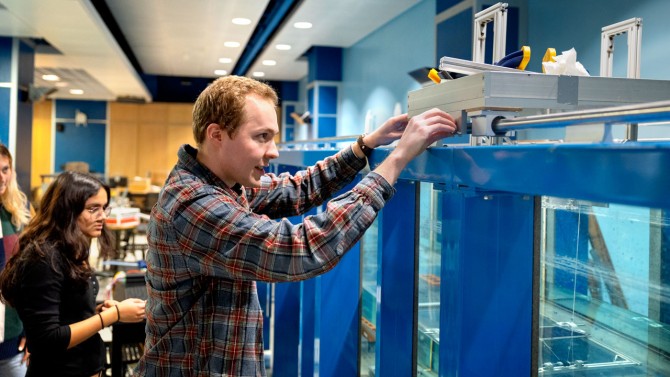Cornell University Students Develop Wave Converters to Harness Ocean Energy
Unlike hydro, solar or wind power, the ocean’s blue waves remain an unexploited source of green energy.
Two Cornell Engineering undergraduates are aiming to advance the science of wave energy converters – devices that catch the waves and transform them into electricity – in order to move the technology closer to reality.
Since last summer, Aisha Brundan ’25 and Kavya Mittha ’26 have been developing converters – an oscillating flap (called the “oscillating surge wave energy converter”) and a bobbing buoy or a heave design (known as the “two-body point absorber”) – at the Symbiotic Engineering and Analysis Lab (SEA Lab), led by Maha Haji, assistant professor at the Sibley School of Mechanical and Aerospace Engineering, in Cornell Engineering.
Brundan said when a wind turbine is placed in an array – such as a wind farm – the air gets disrupted and the turbines create less energy. The same may be true for wave energy converters, except in the ocean there is potential for the arrays to amplify the amount of power produced.
The converters, due to the way they work, can be synergistic. By testing models on a smaller scale in a large wave basin, Mittha and Brundan will see if an array of converters – spaced and organized in various formations – can amplify and grab more energy from the ocean.
“Our plan is to run experiments with both designs in the same area,” Brundan said, “and see how they affect one another.”
Ocean waves contain a huge amount of energy, according to the U.S. Energy Information Administration. Waves forming off the U.S. coasts can theoretically contain 2.64 trillion kilowatt-hours – the equivalent of 64% of the total U.S. utility-scale electricity that was generated in 2021, the agency said.
Bundan and Mittha and their mentors, engineering doctoral students Olivia Vitale and Nate DeGoede, tried small models of their computer-aided designs last summer and fall in a 105-foot-long wave tank at the Joseph H. DeFrees Hydraulics Laboratory. Rebecca McCabe, an engineering doctoral student in Haji’s lab, initiated this project for the lab during the spring 2023 semester.
The DeFrees wave tank is helpful, Mittha said. “It’s small enough that we can lean over into the tank and reach things and tweak our design as we go. That’s advantageous, as we get these converters into the tank to ensure they can generate power.”
The students built two copies of their original design – the heaving buoy – which used a large bobber made of marine-grade foam. They named the devices Meg and Laurie, after characters in “Little Women.” It works like a piston, so when a wave hits the device, the bobber moves up and down, generating power.
Earlier in February, the students completed a prototype of their latest converter fitted with a paddle-like oscillating flap.
“I have always found the concept of renewable energy and power interesting,” Mittha said. “I used to think about renewable energy in terms of wind or solar.
Throughout the process of developing energy converters, I have learned that wave power is a perpetual, untapped energy source.”
Haji’s SEA Lab aims to develop sustainable offshore methods to harness and store that sustainable energy while creating an ocean-based blue economy.
Haji said she left the undergraduates alone to learn. The professor lent them a course textbook in machine design, and they researched the physics, geometries and mechanisms to make effective converters.
When the students test the array, they will mix two types of geometry – the oscillating surge wave energy converters and the point absorbers – to see what happens.
“We think that’s where things will get interesting, since each type of wave energy converters extracts energy from a different degree of freedom,” Haji said. “They learned a lot themselves. Based on what they produced, it’s clear they read the material. Aisha and Kavya conducted good literature reviews to understand other prototypes to get design ideas.”
Wave converters have existed for a long time. In fact, the undergraduates found that arrays of snake-style converters have been tested, but few oscillatory converters, if any, have transformed waves into energy.
“That’s sort of a general concept,” Brundan said. “When using oscillatory wave energy converters, the grid layout of the array and the different degrees of freedom matter on whether the converters amplify one another’s power. This is what no one knows.”
Both undergraduates participated in last year’s pilot Summer Mentored Research program, funded by the Cornell Atkinson Center for Sustainability.
To continue working on the project, Brundan received Engineering Learning Initiatives funding last semester, while Mittha was supported by funds from the President’s Council of Cornell Women. Haji is a faculty fellow with Cornell Atkinson.



